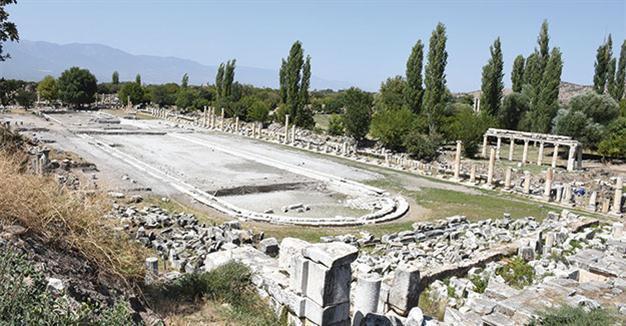Giant pool from ancient city comes to light
AYDIN – Anadolu Agency

AA photo
The ancient city of Aphrodisias, located in the western province of Aydın’s Karacasu district, is home to a giant pool reflecting the magnificence of Roman-era cities that is set to be completely excavated by 2017.Listed on the UNESCO World Heritage List, the city has drawn attention for its well-preserved monumental structures.
Excavations in the city first started in 1904 by foreign archaeologists and were headed by Professor Kenan Erim between 1961 and 1990. Since Erim’s death, Oxford University professor Roland R.R. Smith has been heading the works in Aphrodisias.
The pool, one of the most important architectural elements in the ancient city, is the first one to be unearthed together with a surrounding park and reveals important data about social life in Roman cities 2,100 years ago.
Smith said Aphrodisias was one of most important archaeological discoveries in the world and that many artifacts had been unearthed during excavations so far.
He said the pool was partially excavated for the first time in 1980 by Erim and that works had been continuing for the last five years to unearth it completely.
Excavations on the pool are nearing completion, Smith said, noting that the structure dates back to the first century B.C. and was giant when compared to the size of the city.
“This is a 1.70-meter-long, 30-meter-wide and 1-meter-deep decorative pool. It was made big enough to show the power of the city. Actually, Aphrodisias was not that a big city; its population was low, but works were made to turn it into a metropolis. Roman-era cities were competing against each other in architectural sense. This is why this giant pool was made,” the scholar said.
Reflecting life of the era
The park and the pool in the center was a magnificent structure, said Smith, adding that they had gained important knowledge about the engineering involved in its creation.
“Our research revealed that there were palm trees and inscriptions around the pool. We found small remains of palm trees around it. There is also a channel around the pool to provide water circulation, and the palm remains were inside this channel. We see that this place was a big park. Water was circulated to keep the pool clean. In the first century B.C., people used to come to this pool to chat. We can see the life conditions of people from the graffiti drawn around the pool. Also, there are religious motifs and mind games on the marbles and columns around the pool. People’s good or bad wishes are written here. The pool’s architecture is the one that we know from the Roman era. Local administrators often visited Rome and applied the same architecture there,” the professor said.
He said they planned to unearth the pool completely by next year. “We will finish the project next year when we completely unearth the pool. This park is the only park from the Roman era and is unique. It is a combination of trees, noble architecture and water.”
















